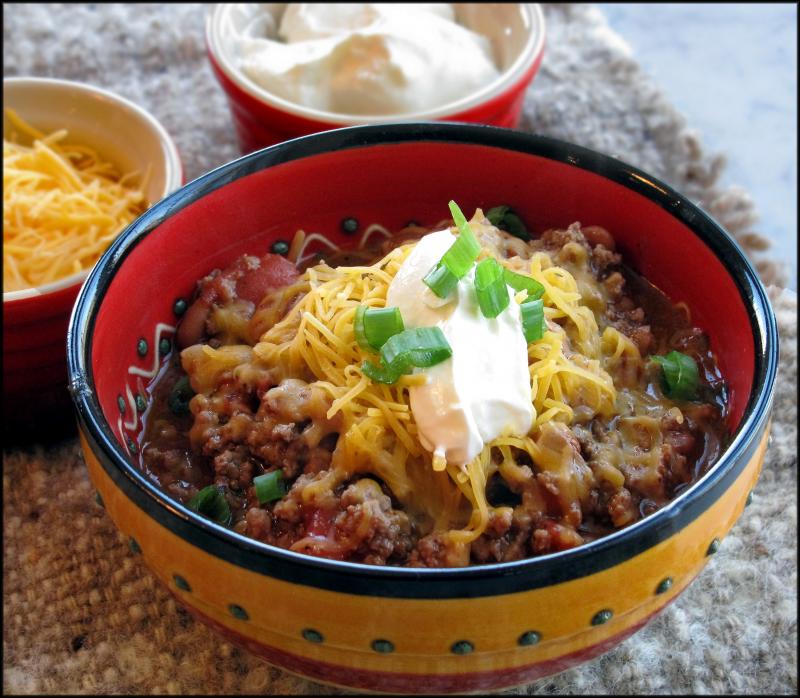Chili con carne is a simple one-pot dish
In an attempt to make fast work of dinner last week, I inadvertently committed a culinary faux pas. Fortunately, Jack was too hungry to notice, and my error went unremarked. A few days later, I was caught when he asked if we had any leftovers to warm up for lunch. I offered him chili, but he voiced his dismay when I served him something altogether different.
By way of explanation, chili con carne (which we’ve shortened to simply call chili) is named for its two primary ingredients: chile peppers and meat. If you look at the history of this simple one-pot dish, you can understand the brevity of the recipe. For almost 2,000 years, the inhabitants of Central and South America have been eating braised meat highly seasoned with ground pepper pods.
During the 1800s, chili became a staple food in the southern and western regions of this country, when cattle drivers and trail hands traveled hundreds of miles to deliver their herds to buyers in Kansas, New Orleans or Saint Louis. Range cooks did not have the luxury of time to age their beef, and they sometimes had to turn to a piece of meat that was not in ideal condition.
And, beef wasn’t the only meat in chili; you might find venison, buffalo or horse instead. The masters of the chuck wagon wisely incorporated the aggressive heat and bold flavor of peppers, along with onion, garlic and native spices such as oregano and cumin. Cooking the ingredients for hours and hours resulted in tenderizing the chunks of meat and melding the complex flavors.
If you look at the bowl of chili in the photo, you can see the problems Jack discovered: beans and tomatoes. The latter were never included in a traditional chili recipe, but someone looking at a bowl of properly cooked chili might assume tomatoes had been stirred into the mix because the spices give the meat a reddish color.
Beans are anathema to chili purists, especially those from San Antonio, Texas, the place often cited as the source of the original recipe. Military Plaza, once a commercial center of the town, was renowned for the Chili Queens who brought their pushcarts to the plaza to sell homemade chili to soldiers, merchants, residents and visitors.
The reputation of the Chili Queens became better known during the 1893 World’s Fair in Chicago where a food booth welcomed visitors to the San Antonio Chili Stand. The Chili Queens were displaced from the plaza in 1937, by order of the city Health Department, but by that time, chili was on the menu at lunch counters and restaurants across the country.
Although cattle-trail chili isn’t made with ground beef, the version popular in Cincinnati is. Except for the addition of beans, typical recipes found in the Cincinnati-style dish are more like Sloppy Joes (supposedly named for the cook who invented it). Unlike the deep heat of chili, Sloppy Joes taste slightly sweet with a bit of tang from Worcestershire sauce and spices.
Our neighbor Bob LaMorte shared his recipe for a modified version of Sloppy Joes - more heat and less sweet in the sauce, and reduced calories from the substitution of minced mushrooms and texturized vegetable protein (tvp) for the beef. This assembles quickly, and Bob’s changes from the standard ingredients will help you forget the Sloppy Joes served in your grade-school cafeteria (go to the Heinz Ketchup website for that one).
I’ve included a chili recipe that originated from one of San Antonio’s Chili Queens as shared by the Institute of Texan Cultures. Based on the ingredient list, you can see why this was a hearty dish favored by cattle drivers.
San Antonio Chili
2 lbs beef shoulder
1 lb pork shoulder
1/3 C flour
1/4 C suet
1/4 C pork fat
3 chopped onions
6 minced garlic cloves
1 qt water
4 ancho chiles
1 serrano chile
6 dried red chiles
1 T ground cumin
2 T oregano
salt, to taste
Cut beef and pork into 1/2-inch cubes. Place the flour in a zip-top bag; add the cubed meat and shake to coat. Melt the suet and pork fat in a large, heavy pot over medium high. Add floured beef and pork cubes and cook quickly, stirring often.
Add onions and garlic, and cook until they are tender. Add water to mixture and simmer slowly while preparing chiles. Remove stems and seeds from chiles and chop very finely. Grind chiles in molcajete (mortar and pestle) and add to the pot. Stir in cumin and oregano. Simmer over low for 3 hours.
Skim off some of the fat and add salt, to taste. *A Chili Queen recipe adapted from the Institute of Texan Cultures.
Bob’s Vegetarian Sloppy Joes
8 oz white mushrooms
8 oz cremini mushrooms
1 T olive oil
8 oz soy crumbles*
2 minced garlic cloves
1 C chopped onion
15-oz can tomato sauce
1 T chili powder
1 T brown sugar
1 T Balsamic vinegar
1/2 t cumin
1/4 t black pepper
hamburger buns or English muffins
Finely chop the mushrooms (resist the temptation to use a food processor or you’ll have mushroom paste). Heat the oil in a skillet over medium and add mushrooms.
Cook, stirring often, until the liquid has cooked off. Remove to a bowl; set aside. Return the skillet to the stove and add the crumbles, garlic and onions. Cook until the onion is translucent and the crumbles are slightly browned.
Return the mushrooms to the pan and stir in tomato sauce, chili powder, brown sugar, Balsamic vinegar, cumin and pepper.
Stir to thoroughly combine and cook for about 10 minutes over medium low. Serve on toasted muffins or buns. Yield: 6 servings.
*Sold dried or frozen, flavored or plain, labeled as texturized soy protein or textured vegetable protein.






















































